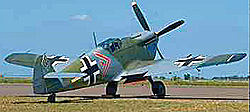 The basic tactical element in the Jagdwaffe was the Rotte,consisting of two aircraft. Two rotten formed a Schwarm and three or four Schwarms made a staffel. Similarly, three or four staffeln formed a Gruppe and three or four Gruppen formed the largest mobile, homogeneous unit in the Jagdwaffe, the Jagdgeschwader.
The basic tactical element in the Jagdwaffe was the Rotte,consisting of two aircraft. Two rotten formed a Schwarm and three or four Schwarms made a staffel. Similarly, three or four staffeln formed a Gruppe and three or four Gruppen formed the largest mobile, homogeneous unit in the Jagdwaffe, the Jagdgeschwader.
The sizes of Gruppen and Jagdgeschwader varied depending on needs and resources. Although the Geschwader was under single command, it did not necessarily operate as a unit, from either the same base or same front. The Jagdwaffe was a very flexible organization, and the subunits were often distributed to various assignments hundreds of miles apart as the tactical situation demanded.
 For identification purposes each Jagdgeschwader was given an Arabic numeral preceded by the abbreviation for Jagdgeschwader, JG. Therefore, Jagdgeschwader number 51 would be written as JG 51. The gruppen were given Roman numerals which appeared before the Jagdgeschwader identification but separated from it by a slash. II Gruppe of Jagdgeschwader 51 would be written as II/JG51.
For identification purposes each Jagdgeschwader was given an Arabic numeral preceded by the abbreviation for Jagdgeschwader, JG. Therefore, Jagdgeschwader number 51 would be written as JG 51. The gruppen were given Roman numerals which appeared before the Jagdgeschwader identification but separated from it by a slash. II Gruppe of Jagdgeschwader 51 would be written as II/JG51.
An Arabic numeral was given to each Staffel, and it was also written before the Jagdgeschwader identification thus: 3/JG 51. The Staffel is identified relative to the Jagdgeschwader in lieu of the Gruppe. Specific Staffeln are assigned to each Gruppe. The staffel written identification tells at a glance the Gruppen and Geschwader as well. Staffeln 1, 2, and 3 were assigned to Gruppe I; Staffeln 4, 5, and 6 to Gruppe II; Staffeln 7, 8, and 9 to Gruppe III; and Staffeln 10, 11, and 12 to Gruppe IV. Therefore 3/JG 51 refers to the 3rd Staffel in the I Gruppe of Jagdgeschwader 51.
With this arrangement, it was necessary to readily identify the various aircraft in the Staffel and a combination of numbers and colors was developed. The planes in each Staffel were numbered from 1 to 12. This number appeared on the fuselage side between the cockpit and the cross. Staffeln 1, 4, 7, and 10 used white numbers, 2, 5, 8 and 11 used red numbers; 3, 6, 9, and 12 used yellow numbers.
Similarly, each Gruppe was given an identification symbol located on the fuselage between the cross and the tail. I Gruppe initially used a round dot, but this was often confused with the British rounder or cocarde insignia and was soon changed to a small Latin cross.
The Staffelkapitan flew plane No. 1 in his Staffel. Special symbols were assigned for the Geschwaderkommodore and his staff, while similar, but not identical symbols were also developed for the Gruppenkommandeur and their staffs. The Geschwaderstab or Geschwader staff flew in their own Schwarm separated from rather than intergrated with The Geschwader.
The accompanying illustrations depict the various Geschwader and Gruppe staff markings that appear between the cockpit and the cross on the fuselage side. The symbols were black with white outlines.
Back to Rebel Yell No. 5 Table of Contents
Back to Rebel Yell List of Issues
Back to Master Magazine List
© Copyright 1997 by HMGS South
This article appears in MagWeb (Magazine Web) on the Internet World Wide Web.
Other military history articles and gaming articles are available at http://www.magweb.com